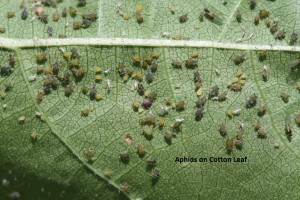Spider mites are increasing or persisting in some fields. To be honest, the unpredictable nature of spider mites makes treatment decisions an educated guess. Late season infestations are less concerning than those starting earlier, but it is important to prevent premature defoliation until most harvestable bolls have matured. Below are some points for consideration.
- Fields need to be protected from excessive defoliation for a minimum of 10-14 days after they reach NAWF5 + 350 DD60s.
- If spider mites are present in low numbers as fields reach NAWF5 + 350 DD60s, it is unlikely populations will “blow up” after this point to levels that will significantly reduce yield.
- During the above time frame, treatment is recommended anytime mites can be found on most plants, and especially anytime defoliation is already occurring in at least some places of the field. The exception might be in irrigated fields where drought stress is not an aggravating factor.
- True miticides will provide the most consistent control. Bifenthrin products such as Brigade and Fanfare may provide some relief, but they may also fail. Abamectin (e.g., Zephyr, Agri-Mek, Abba, Zoro) is the most commonly recommended miticide because it is relatively inexpensive and effective. The common use rate of these products is 5-6 oz/acre. Athena, a premix of bifenthrin and abamectin from FMC, is another option. Other miticides labeled for use include Dicofol, Oberon, Portal, Zeal and Acramite.
 Aphids are also turning up in some fields. This is not unexpected given the dry conditions and recent insecticide applications that have reduced beneficial insect populations. Don’t get too excited by aphids. In late season, even relatively low populations will cause the accumulation of honeydew because plants are no longer growing. A lot of research indicates that treating for aphid infestations is not necessary unless populations are unusually high. Because of the dry conditions in many areas, consider treatment when aphids are numerous on many plants, honeydew is accumulating and especially if plants are showing increased signs of stress (such as wilting where infestations are heaviest). In these situations, infestations will often exceed an average of 50 aphids per leaf. If treatment is needed, my suggestion would be Carbine (1.75 oz/a), Centric (1.75 oz/a), Intruder (0.8 – 1 oz/a) or one of the imidacloprid products at mid to high rates. Products such as Brigadier, Endigo or Leverage would be a good fit where bollworms and stink bugs are also present.
Aphids are also turning up in some fields. This is not unexpected given the dry conditions and recent insecticide applications that have reduced beneficial insect populations. Don’t get too excited by aphids. In late season, even relatively low populations will cause the accumulation of honeydew because plants are no longer growing. A lot of research indicates that treating for aphid infestations is not necessary unless populations are unusually high. Because of the dry conditions in many areas, consider treatment when aphids are numerous on many plants, honeydew is accumulating and especially if plants are showing increased signs of stress (such as wilting where infestations are heaviest). In these situations, infestations will often exceed an average of 50 aphids per leaf. If treatment is needed, my suggestion would be Carbine (1.75 oz/a), Centric (1.75 oz/a), Intruder (0.8 – 1 oz/a) or one of the imidacloprid products at mid to high rates. Products such as Brigadier, Endigo or Leverage would be a good fit where bollworms and stink bugs are also present.
Sticky cotton occurs when honeydew (and sooty mold) accumulates on lint. This can result in harvesting and quality issues. Problems with sticky cotton typically occur in the drier environments of the western Cotton Belt. Issues could occur during an especially dry harvest season, like last year. But sticky cotton is rarely an issue in the Midsouth because rainfall often occurs prior to harvest, washing away the problem.


